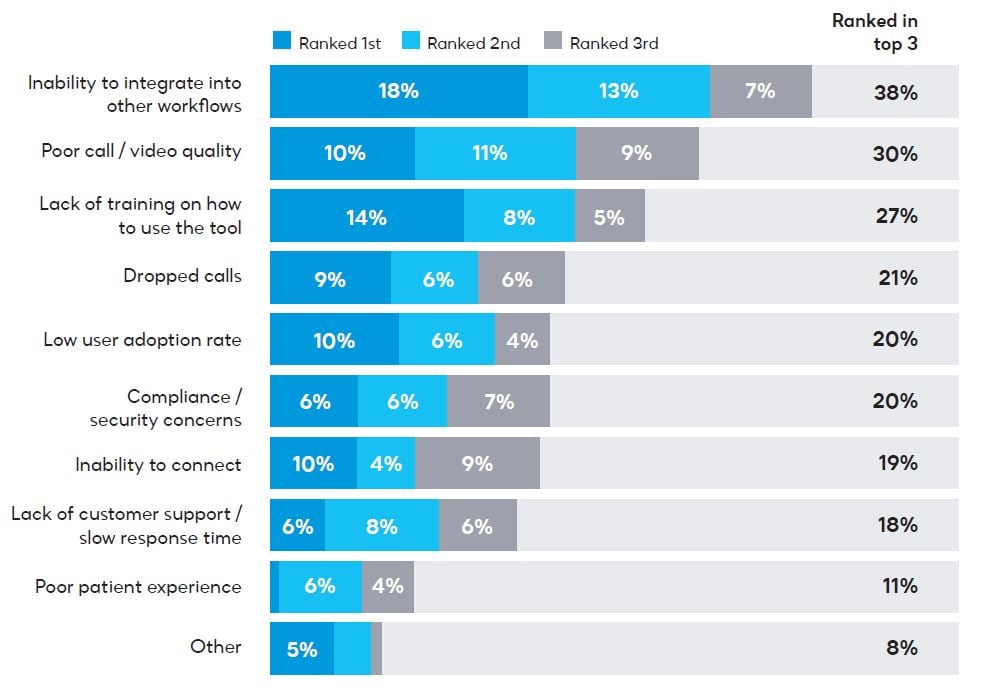Unified communication and collaboration (UCC) platforms can help healthcare organizations better manage outdated and disconnected communication systems.
The goal of any clinician-patient encounter is to understand a patient’s healthcare needs and work toward a diagnosis or treatment. That cannot happen, however, if the video conference or phone call is dropped due to technology issues.
According to McKinsey & Company, the COVID-19 pandemic accelerated the use of telehealth applications through a variety of different virtual communication platforms. With healthcare professionals becoming responsible for managing critical events from afar, Mario Avocato, Account Manager at IR, said it is vital that those encounters are not disrupted by technology failures. Patient outcomes depend on it.
“Your clinicians’ focus needs to be on the patient,” he said. “They are doing everything they can to help patients in a limited amount of time – and that takes a lot of energy. They simply don’t have time for technology that doesn’t work.”
Lost calls mean lost progress and productivity
In a recent research study conducted by HIMSS and IR, survey respondents stated that the most common challenges healthcare employees face when using communication tools include the inability to integrate the tools into other workflows (38%), poor call and video quality (30%) and lack of training on how to properly use the tools (27%). Avocato said these results are not surprising.

“Technology moves at a rapid pace – we are seeing rigorous and accelerated rev cycles. The pace of innovation is just mind-blowing,” he said. “But it doesn’t matter how innovative these tools are if people have trouble using them. They need to be interoperable. They need to be easy to use. People need to be able to marry them into their electronic health record (EHR) and human resources (HR) solutions. Otherwise, they aren’t helping patients.”
Improved connections, better patient outcomes
Unfortunately, outdated and disconnected communication systems can lead to huge problems with productivity and performance. Avocato pointed out that the end result is damage to the efficacy of care. But healthcare organizations that invest in unified communications and collaboration (UCC) platforms can make these disparate systems work better – and work better together.
“You want to find an agnostic solution that has the history and the intellectual property for all your legacy solutions. They also need to be up to speed on the latest and greatest advances,” he said.
“When you can work with one trusted vendor to provide a strong UCC foundation, you can get the interoperability and reliability that you need to find resolution across every communication solution you are using – resolution that will allow your people to stop wasting their time and energy on making tools work instead of focusing on their patients.”
When communication works, everyone benefits
Healthcare organizations that optimize the communication and collaboration tools that connect their providers and patients will be able to improve the human experience for all – and to enable the highest quality care delivery in the process.
With new communication tools coming on the market every day, the industry likely cannot imagine what will be possible within 10 years, according to Avocato. And that makes it even more important that healthcare organizations have a strong UCC management platform in place to support all the tools they need, both new and old, to provide care for patients.
“Thanks to COVID-19, we’ve learned that virtual engagement can be very productive. But there are so many factors that underpin a video call between a patient and provider, from session board controllers to different network components to what computer the patient uses at home to software compatibility issues,” Avocato noted.
“That’s not something your clinicians need to be troubleshooting. You want to have a strong solution in place that allows your team members to have productive discussions and get productive input from patients within and outside of the hospital walls. You need to have the right technologies in place to support these mission-critical communications and help improve patient outcomes.”




